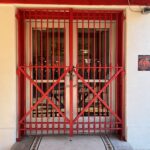I was at a security meeting for one of my projects recently, and I heard the security consultant refer to the “secured side of the door,” meaning the inside – the area that is protected by the security system.
I don’t know about you but my brain was imprinted long ago with the method of determining the hand of a door, starting with, “Stand on the secure side of the door – the side where you would insert your key.” When I heard the term “secured side” I started questioning myself…maybe senility is already setting in. I went to the place where I store most of my brain-power these days – Google, and the first result was the Wikipedia entry for “Door.” In that article it states that “For most of the world, door swings, or handing, are determined while standing on the outside or less secure side of the door while facing the door (i.e., standing on the side you use the key on, going from outside to inside, or from public to private).”
Huh? This is the opposite of what I was taught. I hate it when you’re positive about something and then you start to doubt yourself. Luckily, the 2nd and 3rd Google results were door handing instructions that included the description of the secure side – the side of the door where you would insert your key. This is how I learned it, and how I had it spelled out in my door handing post from way back (I added this to the FAQ page). I checked with a few of my hardware pals and they remembered it the same way I did – the secure side is outside – where you would insert your key. Then I checked with some security consultants and they confirmed that their terminology was the “secured side,” meaning the inside – the area that was secured.
Neither industry could come up with an official definition published anywhere…they are just terms that have, over time, become part of the terminology. Since the two terms are so similar – separated only by one letter – and have the opposite meaning, it’s important to be aware of the potential conflict. For most door applications the secure/secured sides of the door should be obvious, but occasionally it could cause some confusion.
So, I ask you – what terminology do you use and where did you learn it?
You need to login or register to bookmark/favorite this content.





We look at handing from the secure side of the door, the side where you would insert your key. HOWEVER, we provide doors to a security company, and all of their drawings are marked for the Secured side of the door (the side to which you are safe). These openings go into US embassies and other installations around the world. Their concern is where are they secure?
My additional thought on this is that the opposite of secured side is threat side.
The answer is very simple.
In USA and what we learned is that the secure side is the key side.
You are always standing on the corridor side and the key in your hand and you decide also right or left.
The contrary in Europe as the secured side is the side where you are secured (inside the room).
When you are talking about handing, you have to stand inside the room and and then decide right hand or left hand.
Having come from the security industry to the hardware industry, I had to adapt to this as well. DHI has taught me secured side = keyed side. Since all the hardware is affected, I find it easier to stick with the DHI definition and temper my comments and correspondence to security colleagues accordingly.
It seems that if you add a “d” to the word secure, it changes the side of the door that you are standing on.
I learned it this way about 20 years ago.
The door opening is “secure” when you are standing on the key side and cannot get in. It is locked and you can only get through it with a key, thus secure.
Not so from the inside of the room for almost all locks are free egress from the inside.
I can also see access control calling “secured” the inside of the room, meaning safe side.
When dealing with access control folks, I typically talk about key side of a door opening and try to avoid “secure & secured”.
Hope this helps clear things up a little.
I use the term, as an example, “key from corridor 115”. When I use this term I still wonder if it makes sense to everyone reading it.
My experience in detention and security work (which is limited) has been that the secure side refers to the safe side. This is not just for doors, but anything to do with security: walls, fences, windows, gates, doors. etc. And since “security” involves much more than locks for these industries, I think that the door industry may needs to be a bit flexible on this one.
I have been doing this for 42 years and found out long ago that using “keyed” side will usually let everyone know what you are talking about. Nothing worse than sitting in a meeting with an Architect, Owner and Security Contractor where you spend half your time arguing about which side of the door you are talking about.
If you would like to figure out which hand the door is I have a super simple way to remember. All you do is back up against the hinge side of the door. Your behind will be touching it…then pretend your arm is the door…whichever arm opens the way the door does this is the hand of the door. This always works 🙂
I was taught at the “Russwin Contract Hardware School”, way back when dealers from all over the country/world, would send an employee to the factory for 8 continuous weeks of training in the art of architectural builders finish hardware. Handing of a door is always viewed while standing on the outside of the door. This could be the “Key Side”, but what happens when there is a key on both sides? Generally, doors will always have an inside and an outside, (communicating doors could be an issue). Standing “Outside” has never let me down.
What would be the secure side in a communicating door.
That’s a good question…the secure side of each of the doors is the push side, so there would be a LH and a RH.
In our world the “secured side of the door” is that is protected by the security system. Outside the building is a non-secure area. I enjoy your blog. Thanks
In our world the “secured side of the door” has always been the area that is protected by the security system. For example a card reader located on the exterior of a building would be located in an unsecured area.
I agree, the door is kind of irrelevant really, its the space that is defined as secure or non-secure. Another way to consider this is defenders side and attack side respectively.
Another thing that can be confusing is determining handing for a pair of doors. But I can understand the difference that someone from the security industry sees in a “secured” side and a “non-secured” side. I think of a safe and how something inside of the safe is on the “secured” side.
I’m a security professional well versed in door hardware. This is how I explain it with minimal mental gymnastics – the “secured side” of a door is a protection barrier requiring a credential or key to enter the “secure area” beyond it. With electrified hardware, fail-safe and fail-secure features directly affect functionality of the secured side upon power loss (with fail-safe making the secured side actually unsecure).
I started out at a company that did security systems for mostly jails and airports. The terminology they taught me is public (meaning outside) and secure ( meaning inside). Maybe that should have been secured instead, but whenever I’ve used that terminology nobody has been confused about it.
In IT, what side of the firewall would you think is secure. On the public facing internet side or behind the fire wall? I know old habits die hard, but the security industry in every facet has matured a lot in the last 20 years and it may be time to see this odd little piece catch up. It would sure make it less confusing on general contractors if we were all speaking the same language 🙂